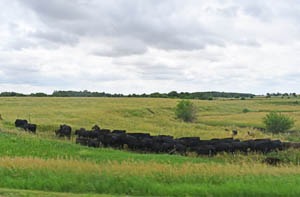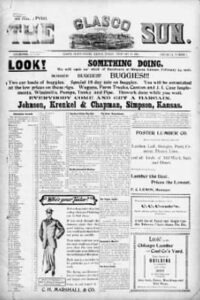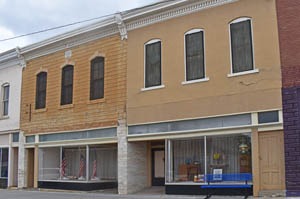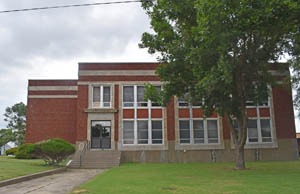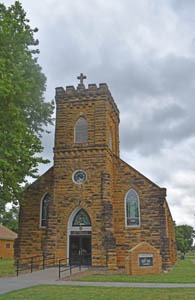Glasco, Kansas, located in the southwest corner of Cloud County, is a small town along the Solomon River.
The area’s first residents were Pawnee Indians living in a village on the Solomon River’s banks, near where Glasco would later be established.
After the Civil War, the Solomon Valley was opened to soldiers and widely advertised. The rich soil enticed settlers to come to the area. The first permanent settlers, Robert Smith and John Henderson, arrived in 1865. In March 1866, John and Jeanette Hillhouse, emigrants from Scotland, arrived and located a homestead on the Solomon River the next month. H.H. Spaulding and A.D. Teasley soon followed them. Another early pioneer was Isaac Biggs, who received a Revolutionary Land Grant from the U.S. Government.
Moving bands of Indians created alarm in the Solomon Valley. On August 11, 1868, Indian raids in the locality resulted in tragedies in Ottawa and Mitchell Counties and Glasco.
The first school was established in 1868.
On December 13, 1869, a post office was established with Captain H. C. Snyder, a Civil War veteran, as postmaster. A stockade was soon built for protection from the Indians, and Glasco’s first settlers spent one winter in the stockade.
On July 18, 1871, H. H. Spaulding, A. H. Spaulding, Jim Copeland, H. C. Snyder, and J. A. Potts founded the Dell Ray Town Company, and the town was soon platted. The company’s purpose was to establish a townsite and sell the lots, blocks, and subdivisions.
That year, Isaac Biggs constructed a frame building to house a general merchandise store. The post office was then moved to the building, and Biggs became the second postmaster.
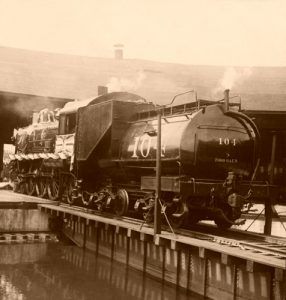
Union Pacific Railroad Engine by H.C. White, 1905.
The Solomon Valley Wool Growing Association was established in 1875, the first in the state.
In 1878, Isaac Biggs submitted a name change of “Glasco” to the state legislature. When the Union Pacific Railroad reached the area that year, they preferred the new name. The change was submitted for the Scotch settlers in Glasgow, Scotland, but was misspelled when submitted by Mr. Biggs.
The arrival of the railroad stimulated substantial growth for the fledgling town. Soon, E. R. Haynes, Glasco’s first railroad operator and station agent, established the Haynes House Hotel and restaurant. W. R. West & Co. established a grain elevator.
In 1880, Isaac Biggs constructed a more permanent general store at the northwest corner of Main and Fisher Streets. The first stone building in town housed the store on the main floor and the Knights of Pythias lodge on the second floor. Later, it housed a harness shop, a hardware store, a wagon shop, a physician, the Kansas Telephone Company, and a laundromat. The building continues to stand today and is now home to the Glasco Historical Society Museum.
That year, the first newspaper, called the Glasco Banner, was established.
The Glasco Sun, first published on January 20, 1883, continues to operate today.
In 1883, William G. Cutler, in his book History of the State of Kansas, said that Glasco was “destined to be the metropolis of the southern and western part of the county.” At that time, the town boasted a doctor, a druggist, a hotel, a newspaper, a blacksmith, a livery, a harness shop, a grocer, a flour mill, a grain elevator, two lumber companies, and retail stores that sold clothing, hardware, shoes, and furniture.
In 1884, a fine iron truss bridge was built at Pott’s Ford, one mile south of Glasco. Today, the bridge is listed on the National Historic Register and is still in use.
Glasco was incorporated as a third-class city on April 14, 1886, and W. R. West was elected the first mayor.
J. W. Studt and his brother Adam established a dry goods and grocery business in 1887.
In 1896, the Glasco High School was established.
In 1899, Glasco’s status as a regional commercial center was sealed by constructing a second bridge crossing the Solomon Rivet one mile southeast of town. This additional river crossing set Glasco apart from neighboring communities by providing unimpeded access to the railroad and abundant goods and services offered downtown.
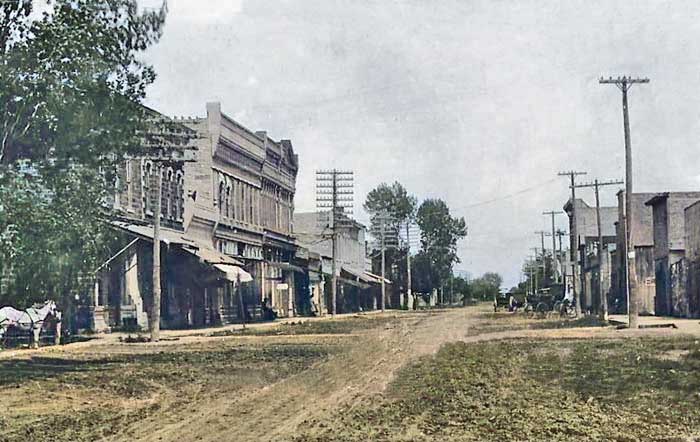
Glasco, Kansas Main Street, 1910. Touch of color by LOA.
By the early 20th century, Glasco played the role of most small cities that supported the surrounding agricultural community with railroad access. At that time, the city’s downtown commercial and industrial center was composed of solid limestone buildings, generally two stories in height of “modern architecture.” The town boasted a fire company, five churches, an opera house, Masonic and Odd Fellows halls, a bank, a photographer, a shoemaker, a three-story hotel and restaurant, and baseball and football teams.
In 1902, J. W. and Adam Studt built a new building for their store. The first floor has functioned as a general merchandise/grocery store. The second floor functioned as a meeting hall, first for the International Order of Odd Fellows (I.O.O.F.) and later for the American Legion. For the first half of the 20th century, it was known as the most complete general store in the region. The building still stands in Glasco today.
The next year, the Foster Lumber Company, founded in 1879 and based in Concordia, established a Glasco location at the corner of Buffalo and Fisher Streets.
In September 1903, an annual livestock show was held in Glasco. In the next years, the event, which included exhibits, dances, concerts, ball games, and parades, grew rapidly and became one of the most widely attended events in the county.
By 1910, Glasco Main Street was lined with one and two-story commercial buildings for two solid blocks. Light industrial businesses extended one-half block to the north and south from the primary intersections. At that time, it had two banks, an international money order post office with four rural routes, express and telegraph service, telephone connections, the Sun weekly newspaper, an opera house, graded and high schools, churches of the leading denominations, two hotels, five general merchandise stores, three grocers, and four restaurants. Service providers included three carpenters, two druggists, two physicians, two barbers, two millenaries, two attorneys, a dentist, and a real estate dealer. The town’s population was 720.
In 1911, Glasco’s downtown area suffered a terrible blow when a devastating fire erupted along Main Street. Although a fire company existed, it was no more than a “bucket brigade,” and with no city water system, the nighttime fire burned almost out of control. It destroyed more than half of the block’s north and south sides between Railroad Avenue and Fisher Street, including the opera house and the impressive Davidson Block. The estimated damages were approximately $225,000, with only $40,000 of insurance coverage.
Despite the devastation, the town was rebuilt, and before long, nine new one-story limestone commercial buildings replaced the ruins on the north side of Main Street. These included a new theater, an auto service garage, and several new retail businesses. Other new buildings were constructed on the south side of Main Street, which housed the telephone company office, a dress shop, Farmer’s State Bank, a barbershop, the post office, and McDowell groceries.
Within 12 months, city water and electricity were installed, and the principal streets were paved. By 1917, the existing water tower just off Main Street had been constructed, and wastewater and sewer lines had been laid, completing the city’s major infrastructure improvements.
Main Street was solid again in less than five years, with brand new one and two-story commercial buildings. At that time, the buildings hosted a millinery, a cafe, a bakery, a tailor, a meat market, a photo gallery, a hardware store, an optometrist, watch and clock repair, and Harley Davidson motorcycle sales.
In 1914, the Transcontinental Midland Trail came through Glasco along Main Street.
The Glasco Rural High School was established in 1920, and the present high school was also built. The Glasco High School remains in use today.
The national prosperity of the 1920s reinforced the stability of Glasco’s economy, although very little new construction occurred in the downtown retail district. However, due to the popularity of the automobile, street lampposts were installed, and at least two new gas stations were constructed along Main Street.
In 1929, the Glasco Cooperative Creamery Company constructed a brick dairy processing building at the southeast corner of Buffalo and Railroad Avenue.
During the Great Depression and the drought of the 1930s, growth came to a near standstill. In 1933, the year Farmer’s State Bank closed.
In 1950, Glasco’s Grade School was built, which still serves grades K-8.
In 1951, the Solomon River swelled over its banks and brought about 18″ of water to Main Street, resulting in superficial damage to storefronts. However, the flood destroyed the 1899 bridge southeast of town, and by 1953, it had been replaced.
In 1960, Glasco’s population peaked at 812.
In November 2002, Glasco’s Downtown Historic District was placed on the National Register of Historic Places. It includes both sides of Main Street between Fisher Street and Railroad Avenue. This district’s period of significance, 1880-1948, is noted for its architecture and as a commercial retail and light industry district. There are 22 contributing buildings, including the Studt Grocery Store and the Biggs Building.
Pott’s Ford Bridge, located about a half-mile south of the city limits, is also on the National Register of Historic Places.
Today, the population of Glasco is about 455.
Glasco is located between Beloit and Clay Center on U.S. Highway 24, about 20 miles southwest of Concordia.
©Kathy Alexander/Legends of Kansas, updated April 2024.
Also See:
Sources:
Blackmar, Frank W.; Kansas: A Cyclopedia of State History, Vol I; Standard Publishing Company, Chicago, IL 1912.
Cutler, William G; History of Kansas; A. T. Andreas, Chicago, IL, 1883.
Glasco, Kansas
National Register of Historic Places
Solomon Valley Highway 24 Heritage Alliance
Wikipedia


